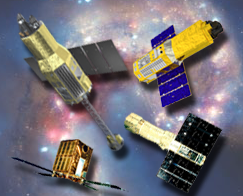What a great day! I’m looking at the world through X-ray glasses!
My detectors are finally cold again, so I can see X-rays for the first time since I got here. I got down to 60 millikelvin, and they put a radioactive iron source in front of me, and I saw it! The iron source puts out X-rays with an energy of 5.9 keV, which is in one of the prime energy ranges I’m designed to look at. So after this long trip and all that I’ve been through, everything is still working well. See, I knew I was fine.
Unfortunately, now comes the poking and proding. They want to see if I can keep operating under a small range of temperatures, and with other things going on. They also want to measure my eyesight reeeeeeeeally carefully.
Oh yeah, what’s a keV? It’s the energy required to move 1000 electrons through 1 volt. What? That doesn’t mean anything? OK, It’s 1.6 × 10-16 Joules. A 100-mile per hour fastball has an energy of 143 J. So 1 Kev isn’t much, is it. But astronomers use keV to measure energy in the em spectrum. So 1 keV is about 1 Ångstrom, i.e. near the low end of the x-ray portion of the spectrum. (I learned something spending time with all these scientists!)




